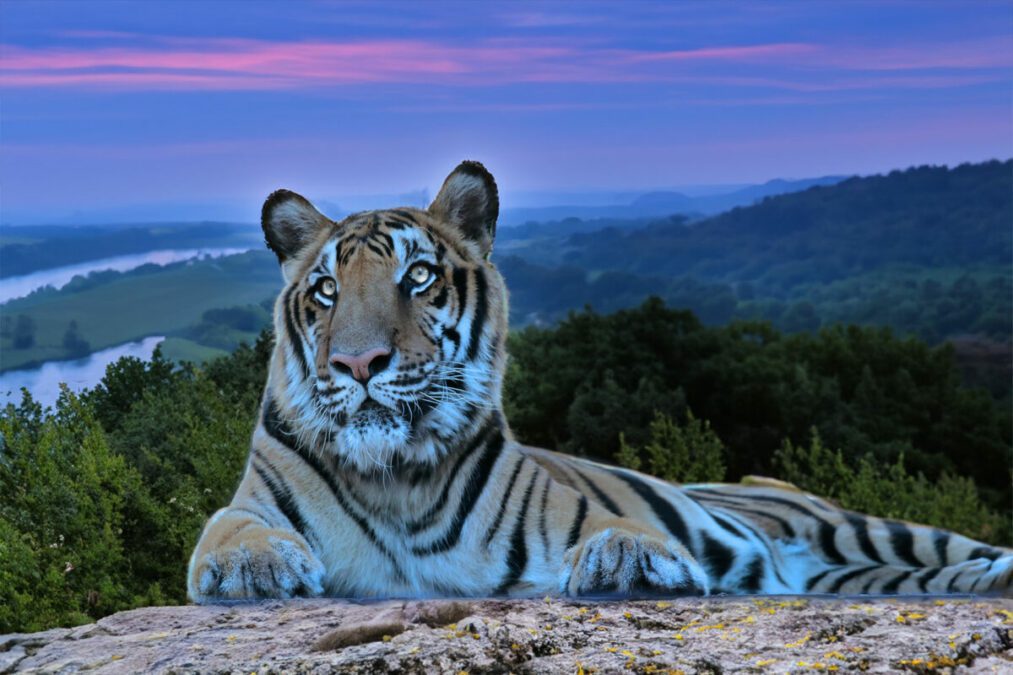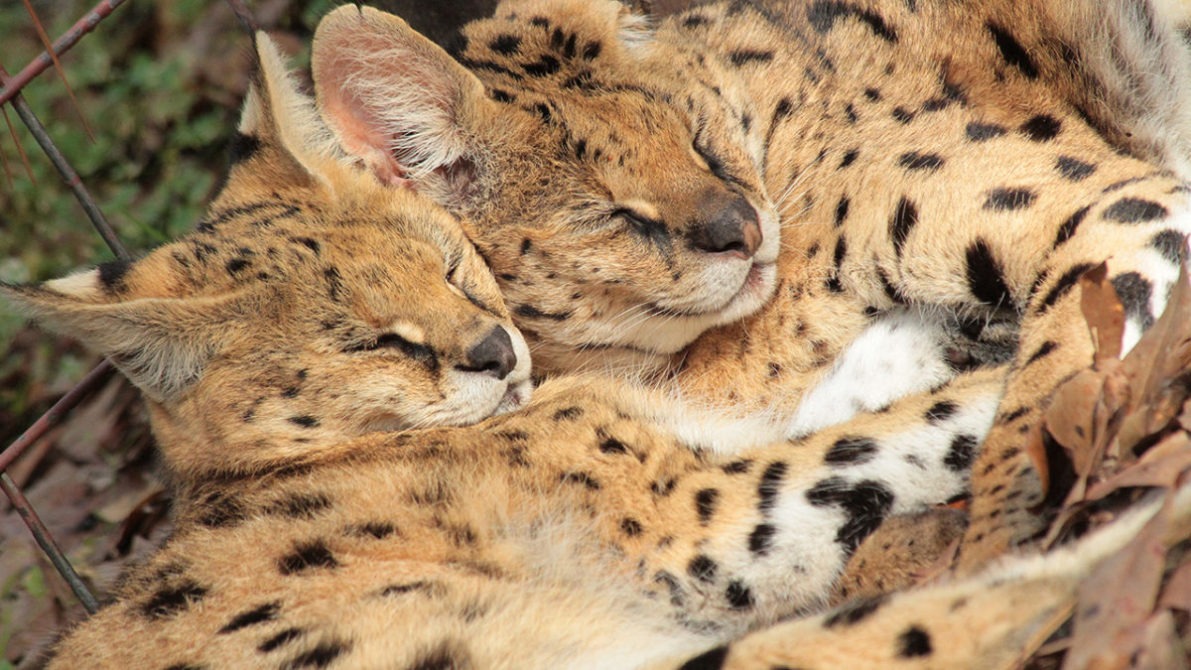2021 Annual Report
29 Years of Saving Big Cats Thanks to YOU!
Some of the most impressive work to save big cats has been done by big cat lovers joining their voices to end abuse and pooling their resources to save exotic cats in the wild before they are all gone.
The Cats YOU Rescued
| Bobcat Name | Species | Rescue Day | Appx DOB |
| Denali, Lily & Ambrose | Bobcat | 5/18/2021 | 8 wks? |
| Cahira | Bobcat | 5/18/2021 | 4/1/2021 |
| Pia & Venkman | Bobcat | 5/19/2021 | 6 mos. |
| Byrdie | Bobcat | 6/21/2021 | 4/1/2021 |
| Nakoa | Bobcat | 7/2/2021 | 4/9/2021 |
| Summer | Bobcat | 7/21/2021 | 7/4/2021 |
| Autumn | Bobcat | 11/1/2021 | 8/1/2021 |
| Isolde | Bobcat | 12/16/2021 | 12/17/2021 |
| Malaya | Bobcat | 8/31/21 | 4/1/2020 |
You can keep up to date on the progress of all our rehab bobcats via remote cameras at https://bigcatrescue.org/cams/
There were 6 more bobcats we tried to help throughout 2021 but were either dead on arrival, or we were unable to track down and catch. We submitted the carcasses on all of the deceased cats to the Florida Wildlife Commission’s biologists who are trying to discern the nature of the coronavirus that is killing Florida panthers and bobcats enmasse. The virus causes neurological issues making it impossible for the cats to walk.
Saying Goodbye to Cats We Loved
We said a tearful goodby to these precious cats: Pharaoh Serval 21, Sapphire Tiger 11?, Tom Tom Bobcat 22, Breezy Bobcat 25, Purr-fection Ocelot 25, Amanda Tiger 25, Sheena Serval 18, Nikita Lion 20 and Simba Savannah Cat 16. Captive breeding harms the survival of exotic cats in the wild.
Our Cats
Long Healthy Lives

By the end of this year, we have 49 exotic cats and 22 of them are over the age of 12. 8 of those are over the age of 18, and 6 of those are over the age of 20. This is well beyond how long they are designed to live in the wild and much older than most zoo cats.
Foster Kittens
Due to COVID-19 and the negative impact of Tiger King, Murder, Mayhem & Madness making it impossible for us to trust unknown interns on site, we had to give up our foster kitten work in 2020-2021. It’s just not been the same without the dozens of precious kittens in our lives and we hope to resume soon.
Abandoned Big Cats 2021
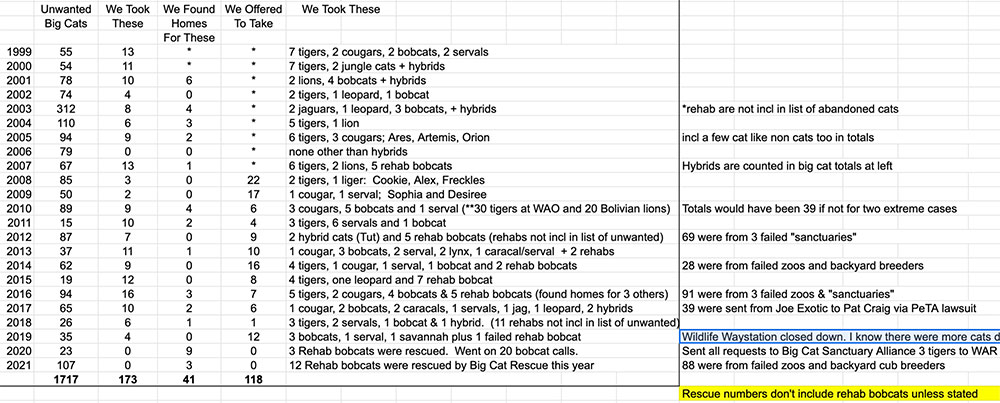
In 2021 we fielded calls to place 3 exotic cats with members of the Big Cat Sanctuary Alliances. As part of this group, we refer incoming calls so that the cats can be placed at the nearest member location who has space and resources. 88 of the big cats who were abandoned in 2021 came from failed zoos and cub mills. (Not on the chart are 10 tigers shipped from the GW Zoo to Tiger Haven in 2020 and then 49 big cats sent from GW Zoo and Jeff Lowe to Tiger Haven in 2020 or 2021.) In 2021 we did not take in any exotic cats because our sister sanctuaries were happy to do so and it freed up our resources for ending the trade at its root. All of our rescues were native bobcats for rehab and release back to the wild this year.
Advances
We know how important it is to maintain transparency and without tours we have decided to install 46 LIVE cameras in 2020 and were working on that throughout 2021 despite many setbacks due to supply chain issues and Internet connectivity. We have really stepped up our LIVE video offerings on Facebook, YouTube, Instagram and other streaming platforms. We are working with Verkada on the camera installation and they have promised to reduce our Internet, Cable, WIFI and cell costs sufficiently to cover the cost of the cameras and hosting, while increasing our speeds, so it was an easy decision to make.
Advocacy
We had to let go our Director of Outreach and Advocacy, as well as our Public Relations Director due to budget cuts in 2020, but that didn’t slow down our Advocacy. Our online team, led by LaWanna Mitchell and assisted by Deb Quimby, have produced stunning results by recruiting, training, mentoring and leading hundreds of big cat lovers in efforts to educate the masses about why big cats belong in the wild; not cages.
Legislation
This year marked the start of the 117th session of Congress and our sixth attempt to pass the Big Cat Public Safety Act. Representatives Quigley and Fitzpatrick introduced our House bill H.R. 263 on Jan. 11, 2021 with substantial bipartisan support. On 4/19/2021 U.S. Senator Richard Blumenthal introduced a Senate companion bill, S.1210. You can help at BigCatAct.com.
InSitu
The work we do to protect wild cats in the wild is too vast to detail here, so you can see all of that at https://bigcatrescue.org/insitu/ Despite having to cut back on expenses this year we still donated $100,800.00 to conservation projects, protecting wildcats, globally. The donations covered projects, supporting 22 different wild cat species, across 18 different countries.
- $5,000 to aid Pallas Cat Conservation in the Steppe region in Mongolia, with a focus on human-animal conflict resolution.
- $1,000 to the Karen Wildlife Conservation Initiative, to aid in the protection of wildlife including Leopards, Tigers and Clouded Leopards, in Burma. The initiative targets direct threats such as extraction, trade and consumption of wildlife for the expanding black markets in East Asia. A large number of mammal species are threatened by hunting and trade, as either direct targets or incidental by-catch. Big cats, particularly tigers, are targeted for their coats, bones, teeth and claws which are used in traditional medicine and as trophies.
- $1,000 to Wildlife and Nature Protection Society, for threat reduction for Sri Lankan wild cats, including Leopards, Rusty Spotted Cats, Jungle Cats and Fishing Cats. The society is focusing on a number of future programs including public education in identified high conflict areas, a compensation program for livestock losses to mitigate retaliatory killings and a long term conservation action plan, with the input and collaboration of Wildcat research specialists across Sri Lanka.
- $1,000 to Maasai Wilderness Conservation Trust, which focuses on the Maasai landscape and the communities of Kenya’s Chyulu Hills, in southern Kenya. The trust aims to conserve the wildlife and cultural heritage of the region, while raising awareness of understanding within local Maasai communities. Programs include compensation for livestock losses, to alleviate the burden of living with wildlife for the local Maasai community, in agreement to not kill but protect local predators.
- $7,500 to The Fishing Cat Project, to aid research and conservation activities in two states of India. In Odisha, The Fishing Cat Project is working to conduct the first population estimation of the Fishing Cat outside protected areas, in an effort to successfully manage populations and introduce efficient threat reduction programs. In West Bengal, the project aims to continue current conservation work, building stronger networks with enforcement agencies to prevent hunting and encouraging local people to join in conservation efforts.
- $1,000 to Tsavo Cheetah Project, who are working together with the Kenya Wildlife Service (KWS) on long-term, effective cheetah conservation and monitoring programs in the Tsavo region of Kenya. The aim of the Tsavo Cheetah project is to protect and conserve the Tsavo ecosystem cheetah population, for the long-term survival of the species. They work with stakeholders and communities in addition to governmental bodies to foster the coexistence with local residents and influence wildlife laws and policies.
- $12,500 to The Geoffrey Cat Working Group. The funds will be split between a network of researchers and conservations, working to protect and mitigate threats to Geoffrey Cats throughout their distribution range in South America. Individuals will work together with other individuals from different regions to share tips, techniques and findings on the species, to help build an overall idea of the species status and needs. Since Dec 2020 30 members across 6 countries have joined the working group.
- $1,000 to Borneo Nature Foundation and their Borneo Wild Cats initiative. The initiative was started in 2008, focusing on key questions about wild cat density and abundance in an under-studied habitat, while investigating and mitigating threats facing them. The Bornean tropical forest contains a guild of five felid species: Sunda clouded leopard, bay cat, marbled cat, flat-headed cat and leopard cat . The initiative is the first long-term, intensive camera-trapping study of clouded leopards and other felids in Indonesian peat-swamp forest aiming to increase knowledge on ecology, behavior and conservation status.
- $1,000 to Wildlife Alliance. Southeast Asia is at the epicenter of the global extinction crisis, and Wildlife Alliance delivers a unique and successful model of hands-on direct protection to 1.3 million hectares of the Cardamom Mountains rainforest, one of the last unfragmented rainforests in the region. In 2001 Wildlife Alliance partnered with the Cambodian government to implement a complete approach to combating the illegal wildlife trade through their award-winning wildlife police unit – the Wildlife Rapid Rescue Team. The team investigates trade networks, apprehends wildlife traffickers, and rescues and releases animals that have fallen victim to the trade.
- $1,000 to Primero Conservation, an established 501(c)(3) nonprofit that works with ranches, landowners, and other organizations in Arizona, New Mexico, and Sonora to improve wildlife habitat and provide alternative solutions to wildlife conservation and natural resource management. In 2015 they initiated Project WILDCAT focusing on protecting and increasing threat mitigation for native wildcats, including Jaguars, Cougars and Ocelots.
- $5,000 to the Ocelot Working Group and Animal Karma for small wild cat threat mitigation in Morelos, Mexico. Morelos has registered all 4 of the small cat species that reside in Mexico, but this is one of the first conservation projects to be initiated for their benefit. Part of their team is made up of local students who receive training and on the ground training to become future conservationists. The target species for this initiative is Margay, Ocelot and Jaguarundi.
- $5,000 for African Golden Cat conservation initiatives in Africa. The root cause of poaching is lack of employment and lack of income for local communities, so the African Golden Cat Conservation Alliance and Working group aim to provide communities with alternative income sources and personal aid such as healthcare and livestock, in return for anti-poaching commitments and conservation assistance for the African Golden Cat.
- $1,800 for Oncilla threat mitigation in Costa Rica. The Oncilla project examines the effects of a major highway on oncilla movement and genetics.
- $1,000 to the Zambian Carnivore Project, a non-profit Zambian-registered trust working in close collaboration with the Department of National Parks and Wildlife (DNPW) and dedicated to conserving large carnivores, and the ecosystems they reside in, through a three pronged approach of Conservation Science, Conservation Action, and Conservation Capacity. ZCP is working to decrease threat to local wildlife including big cats such as lions, leopards and cheetah, by targeting poaching & snares, decreasing human-wildlife conflict, improving habitat connectivity and wildlife corridors, mitigating disease from feral dogs and instilling a Wildlife Crime unit to combat the emerging wildlife trade in big cats.
- $5,000 to the Pampas Cat Working Group, a network of conservationists and researchers that study and protect the pampas cat across its distribution in South America. Their main goal is to implement threat mitigation activities that will ensure the survival of this small wild cat in the current biodiversity crisis.
- $1,000 to WildEarth Guardians, a non-profit 501c3 organization established in 1989, that protects and restores wildlife and wild places in the United States, while working towards coexistence between humans and wildlife. Their wildlife program uses legal means to obtain formal listing under the Endangered Species Act for species nearing extinction, seeks to protect native carnivores like mountain lions, Canada lynx and bobcats, and restore native carnivores to their natural habitat. They also work to decrease direct threats to wildlife including trapping, poisoning and snaring.
- $1,000 to Working Dogs for conservation, the world’s leading conservation detection dog organization. They are pioneers in using dogs’ extraordinary sense of smell to further conservation and aid in the fight against wildlife trafficking. Working Dogs for Conservation trained dogs to locate the scats of grizzly bear, black bear, mountain lion, and wolf in the Centennial Mountain Range to non-invasively collect data. The data is used to determine habitat selection and movement patterns of the species to better understand and manage conservation plans.
- $29,000 from International Tiger Day 202, to continue support of the Corbett Foundation and their tiger wells initiative in Bandhavgarh Tiger Reserve in India. The initiative works to install chain-linked fencing around open farm wells, to prevent accidental drowning of animals such as tigers & leopards in and around the reserve. Big Cat Rescue has supported this project since 2016.
Community Outreach & Events
It was almost all virtual this year with a few exceptions. Texas Animal Control Association conference. DC Lobbying in December.
More Wins for Exotic Cats
05/2021 The South African government made a landmark decision to end the country’s controversial captive lion industry. One reason given by Barbara Creecy, the environment minister, for shutting down the captive industry was “the risk that trade in lion parts poses to stimulating poaching and illegal trade”, while the official government report highlighted the risk of the “laundering of poached parts” into the legal market. The decision was also shaped by the accusations of severe neglect levelled by conservationists and animal welfare groups for years against the captive industry. The government’s assessment also found that the negative associations of captive lions were damaging to South African ecotourism.
05/25/2021 Nevada legislature passes big cat handling ban. Waiting on the Governor to sign it into law.
5/24/2021 Colorado passed the Traveling Animal Protection Act. It prohibits the use of big cats, elephants, bears, and other wild animals in circuses and traveling acts. Colorado joins California, Illinois, New Jersey, Hawaii, and New York in placing restrictions on the use of wild animals in traveling shows.
USDA issued Official Warnings (which carry no weight as they have no penalties attached) to:
Tanganyika Wildlife Park, LLC Goddard, KS for improper handling of animals.
Zoological Wildlife Foundation (Mario Tabraue) Miami, FL for improper handling of animals.
Adam Burck (circus) Grant, OK for inadequate vet care and inadequate housing of big cats.
Animals of Montana, Inc., Bozeman, MT for improper handling of animals.
The Zoo Foundation Inc Gulf Shores Alabama for improper handling of animals.
Zootastic of Lake Norman, Inc., Troutman, NC for inadequate vet care.
Lions, Tigers & Bears, Inc., Arcadia, FL for improper feeding.
National Foundation for Rescued Animals Tyler, TX for inadequate vet care.
SRI International Menlo Park, CA for improper handling of animals.
Jacksonville Zoological Society Jacksonville, FL for improper handling of animals.
Hollywild Animal Park Inc. Wellford, SC for inadequate vet care.
Safari Adventure Inc. Homestead, FL exhibiting without a license.
Roberta Kirshner Oroville, CA for inadequate number of employees to care for the animals.
Wild Wilderness Drive Through Safari Gentry, AR for improper handling of animals.
Robert Sawmiller Wildlife on Wheels Wapakoneta, OH for multiple violations of the Animal Welfare Act.
Where are the Tiger King zoo owners now?
Where is Joe “Exotic” Schreibvogel Maldonado Passage now?
Joe Exotic is still serving out his 21 year prison sentence after having the 22 year sentenced reduced to 21 on 1/28/2022. He was convicted of 17 violations involving wildlife trafficking and shooting five healthy tigers in the head to make boarding space available for a circus. He was also convicted on murder for hire charges in a plot to have me killed. What most people don’t know is that he’d been rallying his minions to kill me for nearly 15 years by saying I was coming to take their pets from them, including their dogs, cats and goldfish. Failing to motivate anyone to do it for free, in 2014 people started calling me to say he’d offered to pay them do to it. The last person he tried to hire was an undercover FBI agent. On 12/10/2020 the U.S. Department of Justice alerted Joe’s victims that an extra month has been added to his mandatory sentence, so it would appear he can’t follow the rules in jail any better than he could the rules of society. He was also cited for possession of a contraband cell phone.
Where are Jeff Lowe and Lauren Lowe now?
8/20/2021 Jeff and Lauren Lowe hand over the rest of their animals to the Department of Justice. Erik Cowie had gone from working with Joe Schreibvogel to working for Jeff Lowe. Cowie told DailyMailTV that he witnessed Exotic kill over 100 tigers and claimed many of the big cats actually despised the larger-than-life star. “Joe only cared about them in a monetary way.”
9/3/2021 Erik Cowie was found dead, face down in a bed, in a NYC apartment. The only people I can think of that Erik might know in NYC would be Eric Goode and Rebecca Chaiklin and their Tiger King 2 production company.
The Lowes have lost their license to exhibit wild animals which includes showing them in person, via television or the Internet. On 11/19/2020 the Department of Justice filed suit against Jeff and Lauren Lowe for pages and pages of alleged violations of the Endangered Species Act and USDA’s Animal Welfare Act. We know they offloaded 49 big cats to MaryLynn Haven of Tiger Haven in TN (who now has 253 exotic cats as of Nov. 2020) before moving the rest of the animals from the GW Zoo they had to turn over to me on Oct. 3, 2020. We were told that at least one liger died from an overdose administered by Lowe during the move according to the Sheriff who was on hand to insure our crew’s safety. We have heard they also sent cats to Gregg Woody. Read the DOJ’s complaint here: https://911animalabuse.com/wp-content/uploads/2020-11-19-US-vs-Lowe-complaint.pdf
On 12/30/2020 the Department of Justice filed a motion for a Temporary Restraining Order requiring that Jeff Lowe and Lauren Lowe comply with the Animal Welfare Act and give up all of the cubs under one year of age, and their mothers to legitimate sanctuaries to protect their health. The first document is the Motion and the second below is the reasoning behind the motion quoting such egregious neglect and abuse as to cause the deaths of big cats at the Tiger King Park. The brief also suggests that 50 wild cats are unaccounted for in between the time of the Lowe’s July 2020 inspection at the GW Zoo in Wynnewood, OK and the December 2020 inspection in Thackerville, OK.
2020-12-30-US v. Lowe_TRO motion
2020-12-30-US v. Lowe_updated TRO brief
12/17/2020 Lauren Lowe must pay interest on $6,852 of attorney fees and expenses PETA incurred while it enforced subpoenas requiring her to produce documents and sit for a deposition, as ordered by U.S. District Judge Patrick R. Wyrick of the U.S. District Court in Western Oklahoma. A DOJ inspection was imminent at that time as well due to concern for the health and safety of the animals.
The best thing about this lawsuit and the others faced by cub breeders is that it will finally create a legal interpretation that big cat cubs should not be separated from their mothers and should not be handed around as ego props based on it being a “take” under the Endangered Species Act and that doing so is a violation of the Animal Welfare Act. USDA has failed to enforce their laws for years, so the courts are taking charge and doing it. Whether the Big Cat Public Safety Act or the final order in this case comes first doesn’t matter much as both will definitively end the mass production of cubs for this one month window of abuse. That is well over 90% of the captive breeding of big cats who serve no conservation value due to being inbred and crossbred. Captive breeding provides a legal smokescreen for illegal poaching and sales of wild tigers and other big cats for their parts. Whichever comes first will end the era of abuse, once and for all. The only question is; Will it be in time to save the tiger in the wild?
1/21/2022 According to Roadside Zoo News Jeff and Lauren Lowe announce they’re making plans to open a roadside zoo in Mexico: https://www.tmz.com/…/tiger-king-jeff-lowe-moving-zoo…/
Where is Kevin Bhagavan “doc” Antle now?
Kevin Bhagavan “doc” Antle and daughters have been indicted. Bhagavan Antle, who is known as Doc and is the owner of Myrtle Beach Safari in South Carolina, was charged with two felony counts related to wildlife trafficking and 13 additional misdemeanors, according to the Office of the Attorney General of Virginia. Tawny Antle and Tilakam Watterson, daughters of Mr. Antle, are also facing several misdemeanor charges in connection with animal cruelty and alleged violations of the Endangered Species Act. Of all of the big cat exploiters we think he’s the smartest one, but is he smart enough to figure out that continuing to charge people to pet cubs is likely to result in fines, revocation of his license to exhibit and maybe even jail time?
Meanwhile, his season should be over for the winter at Barefoot Landing in Myrtle Beach so hopefully the cub petting storefront is shuttered for the winter. Thanks to a petition by PETA the USDA is requesting that exhibitors do the following: #1. Consult with their attending veterinarians in order to protect the health and welfare of big cats. (No decent vet would approve of cub handling displays) #2. Wear extra protective equipment and practice physical distancing when possible and the biggie #3. Encourage members of the public to keep at least 6 feet away from big cats (and optimally wear a mask when in the vicinity of captive big cats). This effectively ending all cub-petting displays.
11/28/2021 According to Roadside Zoo News Tawny Antle, daughter of Doc Antle of Myrtle Beach Safari, was arrested for unlawfully carrying a pistol. Tawny, Doc and Doc’s other daughter, Tilakum Watterson, are all facing charges for cruelty to animals, wildlife trafficking and violating the Endangered Species Act: https://wpde.com/…/doc-antles-daughter-arrested-in…
Where is Tim Stark now?
Tim Stark and Wildlife in Need has had his USDA license revoked and all of his animals seized. On 2/3/2020 the judge ruled that “Respondents willfully violated the AWA (Animal Welfare Act) on multiple occasions. As set out below, I also find that that Respondents’ business is large, the gravity of such violations was great, there is a history of previous violations, and Respondents did not act in good faith. Therefore, Respondents are ordered to cease and desist from violating the AWA and the regulations and standards issued thereunder; AWA license number 32-C-0204 is hereby revoked; Respondents are jointly and severally assessed a civil penalty of $300,000 for their violations herein; and Respondent Stark is assessed a civil penalty of $40,000 for his violations herein. His animals have been seized and dispersed to other facilities. See the order USDA vs Tim Stark Revoke License
1/3/2022 According to Roadside Zoo News: January 3, 2022 – Tim Stark of the now-defunct Wildlife in Need files for bankruptcy with his biggest creditors being PETA (People for the Ethical Treatment of Animals), the Indianapolis Zoo, and the state of Indiana: https://www.wlky.com/…/tim-stark-founder-of…/38667863
More here: https://bigcatrescue.org/where-are-the-tiger-king-stars-now/
Finances
Click here for 2021 IRS form 990 and 2021 audited financial statement and annual report and USDA Inspection.
Big Cat Rescue has an Endowment Fund to provide a secure future for the cats. The Fund resides at the Community Foundation of Tampa Bay. Periodically the Community Foundation offers a matching program where the nonprofit sets a fundraising goal and when 75% of the goal is reached, the Community Foundation provides the remaining 25%, which effectively is a 33% match of the funds provided by donors. 2021 marks the first year that substantial donations have been made via cryptocurrencies. See https://bigcatrescue.org/nft-leaderboard
Then and Now
Visit https://bigcatrescue.org/about/finances/ to get copies of our 990’s and Audited Statements. We pride ourselves in keeping our fundraising and administrative total expenses below 9%. Because our tour revenue exceeds our fundraising and administrative costs, 100% of donations go to Program Expense (saving big cats).
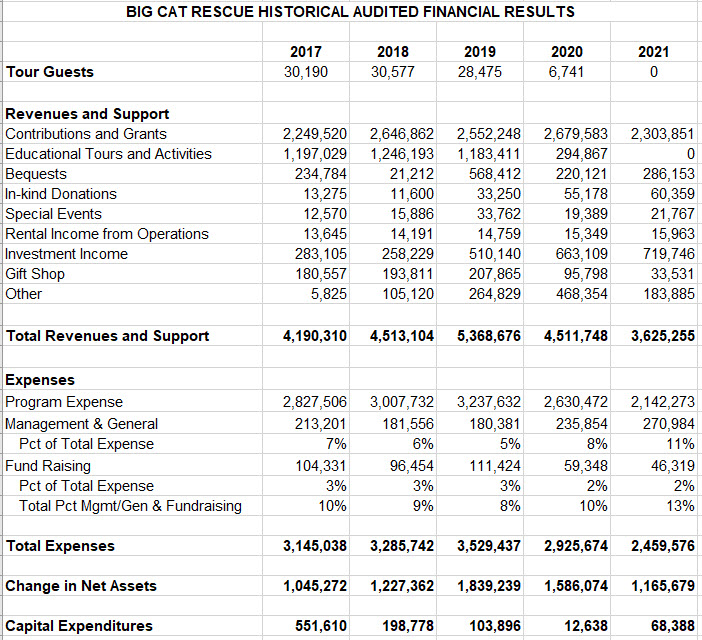
IRS 501 c 3 Determination letter
Social Media
On social media we have surpassed HSUS when it comes to followers. 3,696,875 follow Big Cat Rescue on Facebook now, vs 2,537,099 who follow HSUS. We’ve also surpassed Wildcat Sanctuary this year who has 2,693,246 followers, and World Wildlife Foundation which has 3,567,935 followers. Black Jaguar White Tiger still has 3,881,611 followers but the posts are diminishing in numbers and popularity. I think BJWT’s fanbase will drop dramatically as people have learned that showing off, touching big cats, is what is killing them in the wild. Oddly, Facebook measures popularity by Likes, rather than Followers, but that doesn’t make sense. A like happens once, and is an easy metric to raise by running ads asking people to Like a page, whereas the followers are hearing from the brands every day and thus seem to be a better measure of reach to me.
Compare Our YouTube stats in 2021 to 2020
YouTube continues to send us a lot of traffic. By 2021 year end we had 1,370,000 subscribers and 625,153,197 views on our main channel. In 2021 YouTube revenue was $49,000.

We had 39,500 subscribers and 16,025,067 views on our secondary channel called Daily Big Cat.
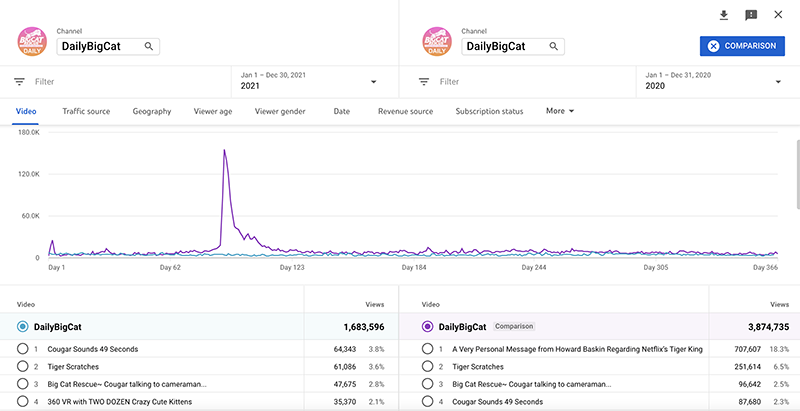
360 3D VR really grew this year with 1,505,566 views and 6,430 subscribers. Viewers of this content are most likely those wearing headsets. The site was created separate from our other channels so that those in VR could subscribe to a channel that only has 360 and 3D content. We also include the 3D content on our primary channel as well and it is beginning to outpace flat videos.
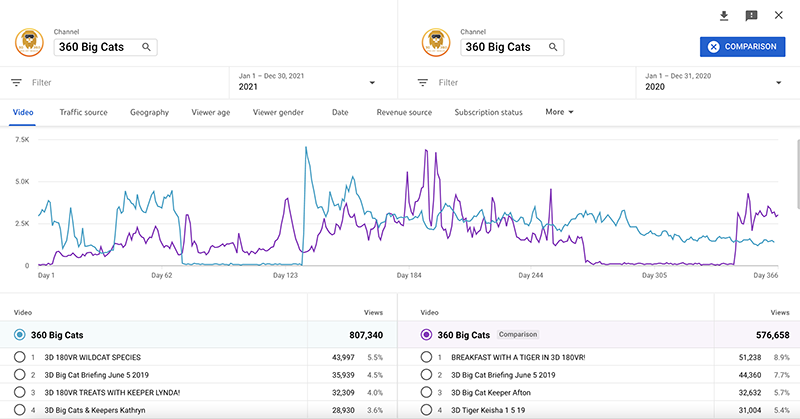
You can find all of our 360 and 3D playlists by checking out:
360cat.tv points to a list of our Facebook 360 videos
360bigcat.com points to our main YouTube playlist of 360 videos
360bigcats.com points to our DailyBigCat YouTube playlist of 360 videos
Our Facebook fans have grown to 2,540,624 million likes and 3,793,298 million followers. Our Facebook efforts reach millions of people in a single week! Some of the best news comes from the fundraising we have been able to do on Facebook which is made especially sweet since Facebook covers the credit card processing fees, so the cats get the full benefit of the donation. Facebook launched subscriptions this year and by year end we had 1,748 people pledging .99 per month. People also did their own Facebook Fundraisers and from our Donate button on the page and in our posts. On Facebook alone 8,973 individuals donated $255,466.75 For the Cats!

Continued using FB ads to generate email sign-ups and for BigCatRescue.biz sales.
Twitter At the end of 2021 we reached 320,500 followers on Twitter.

Pinterest 4,500 followers
LinkedIn 5,512 followers
Instagram 180,000 followers
We are on SnapChat again as bigcatrescuer since we cannot access our original account at bigcatrescue. Our Snapchat activity and followers also boomed this year, with hundreds of viewers per snap!
We launched on Tik Tok in 2019 and closed out 2021 with 3 million likes and 423,400 followers.
The BigCatRescue.org website
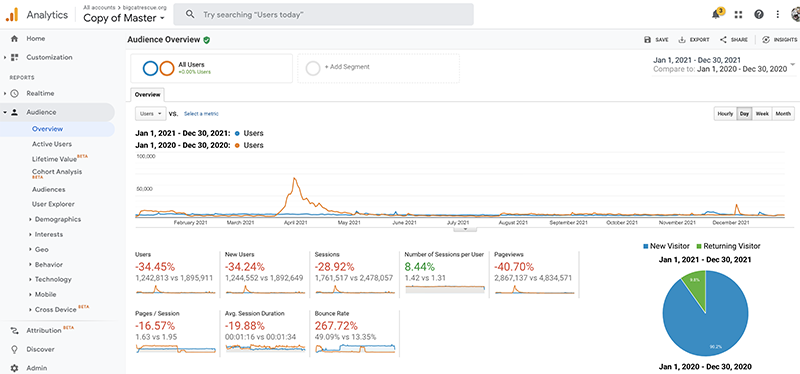
The internal tracking of viewers reports 2,867,137 views in 2021 vs 4,834,571 in 2020. Much of this decline can be attributed to people refusing to leave Facebook to follow a link. As a result we’ve had to duplicate our most informative pages as Notes on Facebook in order for them to be read.
Amazon. A huge shout out to everyone who has donated items from our Amazon wishlist and who has chosen Big Cat Rescue as their charity of choice in https://smile.amazon.com/
Roku. Watch more than 1000 episodes of Big Cat TV waiting for you for FREE in the Channel Store! Now you can check us out on Binge TV too! Series include our best videos from each year going back to 2007. Big Cat Vets, Cat Chat Show, and Big Cat Rescuers, our weekly big cat reality show.
Alexa. Now you can find us on Alexa and can even make a donation by saying, “Alexa, make a donation to Big Cat Rescue.” You can add Big Cat Briefing to your daily briefings and hear daily updates from the sanctuary. You can play a game by enabling the skill called Big Cat Rescue and you can can play a name that cat sound game by enabling a skill called Big Cats. There are even two skills to help you pack for a trip (Travel Checklist) or for school or college (School Checklist). Find out more at https://bigcatrescue.org/alexa/
In the News
Big Cat Rescue was reported favorably more than 32,081times in 2021. Some of our national press has included shows on CNN, MSNBC, National Geographic, Animal Planet, Discovery and the History Channel in addition to such publications as USA Today, National Geographic and the New York Post and major media coverage in several other countries as well.
Mail List. Our mailing list is 99,500 supporters.
Visitors to the sanctuary: We only had about 150 donor tours for those who had given over $500 in the preceding year. We closed our doors March 15, 2020 due to COVID-19
WHO WE ARE
The Big Cat Board
The Board met 4 times in 2021. Board members are: Carole Baskin – Founder, CEO, Director | Howard Baskin – Secretary, Treasurer, Director | MaryLou Geis – Director | Darren Kipnis – Director | Keith Lawless – Director | Lynda Licht – Director | Kim Mahoney – Vice President, Director | Jamie Veronica Murdock – President, Director
Paid Staff and Contractors:
Paid staff & contractors include: Afton Tasler, Brittany Mira, Carole Baskin, Deb Quimby, Erin Carden, Gale Ingham, Howard Baskin, Jamie Veronica, Katie Nikic, Lauren Buckingham, LaWanna Mitchell, Victor Alonso and Ysabel Cruz.
Volunteers:
Big Cat Rescue had 79 volunteers (incl interns) at the end of 2021 who clocked in 39,957.79 man-power hours, in addition to 14 interns did 35 sessions (12 weeks each) who clocked 15,413.29 man-power hours. Between 14 full time paid staff, 1 part-time staff and volunteers we averaged the equivalent of 28 full-time staff.
Between January 1, 2020, and December 31, 2021, Big Cat Rescue provided $234,465 in scholarships to provide housing, transportation, utilities, food, training and entertainment to 14 interns for 23 three month sessions and three Level 5’s doing one full year sessions each, arriving in Tampa, FL from 2 countries and 11 states. (Each 3 month session is roughly $6,699.00 in food, housing and entertainment.)
Battling Coronavirus COVID-19 at Big Cat Rescue
Big Cat Rescue is working to reduce the spread of the Coronavirus in many ways.
The Public and COVID-19 Concerns
We closed our doors to visitors on March 15, 2020 and are still, as of the end of 2021, not having any visitors at the sanctuary. At some point we will resume doing small private tours, but we don’t know when and we plan to be very conservative in making that decision. We don’t know if we will ever resume doing general public tours again. Even after the virus concerns subside, the betrayal by the liars who produced Tiger King, and the lies viewers were told in the series, creates a concern about having visitors we do not know.
Fortunately people who already knew the sanctuary quickly recognized the lies in Tiger King and have been wonderfully supportive, both emotionally with your messages and with your donations. There is really no way to convey how much we have appreciated both of these kinds of support.
Meanwhile check out our online options, such as our LIVE webcams where you can chat with people who love big cats at https://bigcatrescue.org/cams/ and see our virtual options at BigCatRescue.org/VR
We are ramping up all the ways to connect with you on our social sites too at Facebook, Instagram, YouTube, Twitter and TikTok. We have a lot of volunteers who can’t go to work or school right now, so they are getting fresh air and sunshine while helping out our cats. This means more keeper videos to share with you, while you are on lockdown.
Our Staff and Volunteers During the Pandemic
Our volunteers are the ones who provide all of the cat care, and they are scanned for temperatures before getting out of their cars upon arrival. Everyone is required to wear masks while in common spaces, and when in close proximity, like on golf carts or working together. New interns are quarantined for 14 days before allowed on site. Some of our staff are working from home. Our weekly staff meetings are being held via Zoom. The staff and volunteers who are high risk for infection are helping out with our online presence during this crisis as a way to stay sane and help our supporters remain connected despite many being in mandatory self quarantine.
Our Cats During Coronavirus
We have filled our freezers, which can hold about 20,000 pounds of food, in case the production plants or transportation companies shut down. We’ve stocked up on fuel for our generators in our onsite storage tanks. In 2003, the first year Big Cat Rescue was able to break even financially, we began tucking away a little bit into an endowment fund. It’s money we can’t touch outside of an emergency and its purpose was to provide a pension fund for all of our exotic cats. We did it right after seeing tourism and donations come to a screeching halt in the aftermath of 9/11 and knowing what it was like to look at the faces of hungry cats and tell them there would be no food for them short of a miracle. (fortunately for us that miracle happened and no cats went hungry, but that’s a story for another day)
Thanks to our amazing donors the sanctuary’s cats have a fully funded pension that will provide food and vet care for them to the end of their days. We would have to shut everything down, end all of our work to save wild cats from abuse and extinction, and let all of our staff go, but there is money in the Community Foundation endowment fund to be sure the cats don’t starve. Even though we made the tough choices to ensure our cats’ futures, we face an immediate crisis now. In order to keep doing the important work we do, without depleting our savings, we count on your donations more than ever.
See the last 18 years in annual reports:
https://bigcatrescue.org/2020-annual-report/
https://bigcatrescue.org/2019-annual-report/
https://bigcatrescue.org/2018-annual-report/
https://bigcatrescue.org/2017-annual-report/
https://bigcatrescue.org/2016-annual-report/
https://bigcatrescue.org/2015-annual-report/
https://bigcatrescue.org/2014-annual-report/
https://bigcatrescue.org/2013-annual-report/
https://bigcatrescue.org/2012-annual-report/
https://bigcatrescue.org/2011-annual-report/
https://bigcatrescue.org/2010-annual-report/
https://bigcatrescue.org/2009-annual-report/
https://bigcatrescue.org/2008-annual-report/
https://bigcatrescue.org/2007-annual-report/
https://bigcatrescue.org/2006-annual-report/
https://bigcatrescue.org/2005-annual-report/
https://bigcatrescue.org/2004-annual-report/
https://bigcatrescue.org/2003-annual-report/



